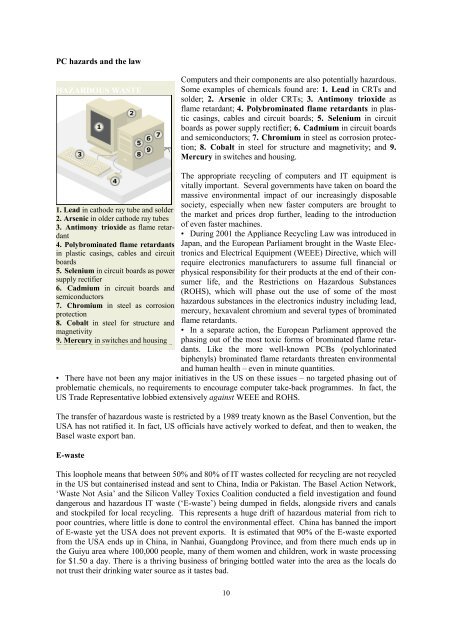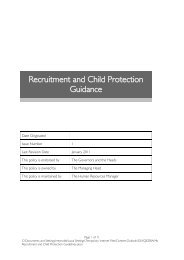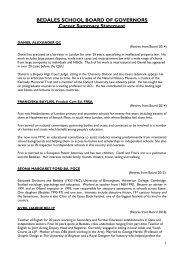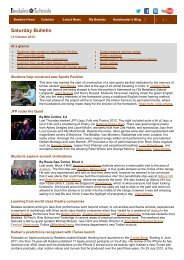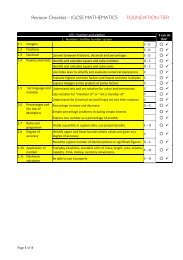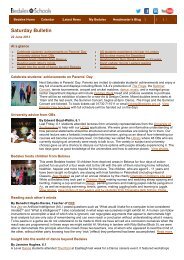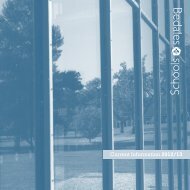You also want an ePaper? Increase the reach of your titles
YUMPU automatically turns print PDFs into web optimized ePapers that Google loves.
PC hazards and the lawHAZARDOUS WASTEComputers and their components are also potentially hazardous.Some examples of chemicals found are: 1. Lead in CRTs andsolder; 2. Arsenic in older CRTs; 3. Antimony trioxide asflame retardant; 4. Polybrominated flame retardants in plasticcasings, cables and circuit boards; 5. Selenium in circuitboards as power supply rectifier; 6. Cadmium in circuit boardsand semiconductors; 7. Chromium in steel as corrosion protection;8. Cobalt in steel for structure and magnetivity; and 9.Mercury in switches and housing.1. Lead in cathode ray tube and solder2. Arsenic in older cathode ray tubes3. Antimony trioxide as flame retardant4. Polybrominated flame retardantsin plastic casings, cables and circuitboards5. Selenium in circuit boards as powersupply rectifier6. Cadmium in circuit boards andsemiconductors7. Chromium in steel as corrosionprotection8. Cobalt in steel for structure andmagnetivity9. Mercury in switches and housingThe appropriate recycling of computers and IT equipment isvitally important. Several governments have taken on board themassive environmental impact of our increasingly disposablesociety, especially when new faster computers are brought tothe market and prices drop further, leading to the introductionof even faster machines.• During 2001 the Appliance Recycling Law was introduced inJapan, and the European Parliament brought in the Waste Electronicsand Electrical Equipment (WEEE) Directive, which willrequire electronics manufacturers to assume full financial orphysical responsibility for their products at the end of their consumerlife, and the Restrictions on Hazardous Substances(ROHS), which will phase out the use of some of the mosthazardous substances in the electronics industry including lead,mercury, hexavalent chromium and several types of brominatedflame retardants.• In a separate action, the European Parliament approved thephasing out of the most toxic forms of brominated flame retardants.Like the more well-known PCBs (polychlorinatedbiphenyls) brominated flame retardants threaten environmentaland human health – even in minute quantities.• There have not been any major initiatives in the US on these issues – no targeted phasing out ofproblematic chemicals, no requirements to encourage computer take-back programmes. In fact, theUS Trade Representative lobbied extensively against WEEE and ROHS.The transfer of hazardous waste is restricted by a 1989 treaty known as the Basel Convention, but theUSA has not ratified it. In fact, US officials have actively worked to defeat, and then to weaken, theBasel waste export ban.E-wasteThis loophole means that between 50% and 80% of IT wastes collected for recycling are not recycledin the US but containerised instead and sent to China, India or Pakistan. The Basel Action Network,‘Waste Not Asia’ and the Silicon Valley Toxics Coalition conducted a field investigation and founddangerous and hazardous IT waste (‘E-waste’) being dumped in fields, alongside rivers and canalsand stockpiled for local recycling. This represents a huge drift of hazardous material from rich topoor countries, where little is done to control the environmental effect. China has banned the importof E-waste yet the USA does not prevent exports. It is estimated that 90% of the E-waste exportedfrom the USA ends up in China, in Nanhai, Guangdong Province, and from there much ends up inthe Guiyu area where 100,000 people, many of them women and children, work in waste processingfor $1.50 a day. There is a thriving business of bringing bottled water into the area as the locals donot trust their drinking water source as it tastes bad.10


